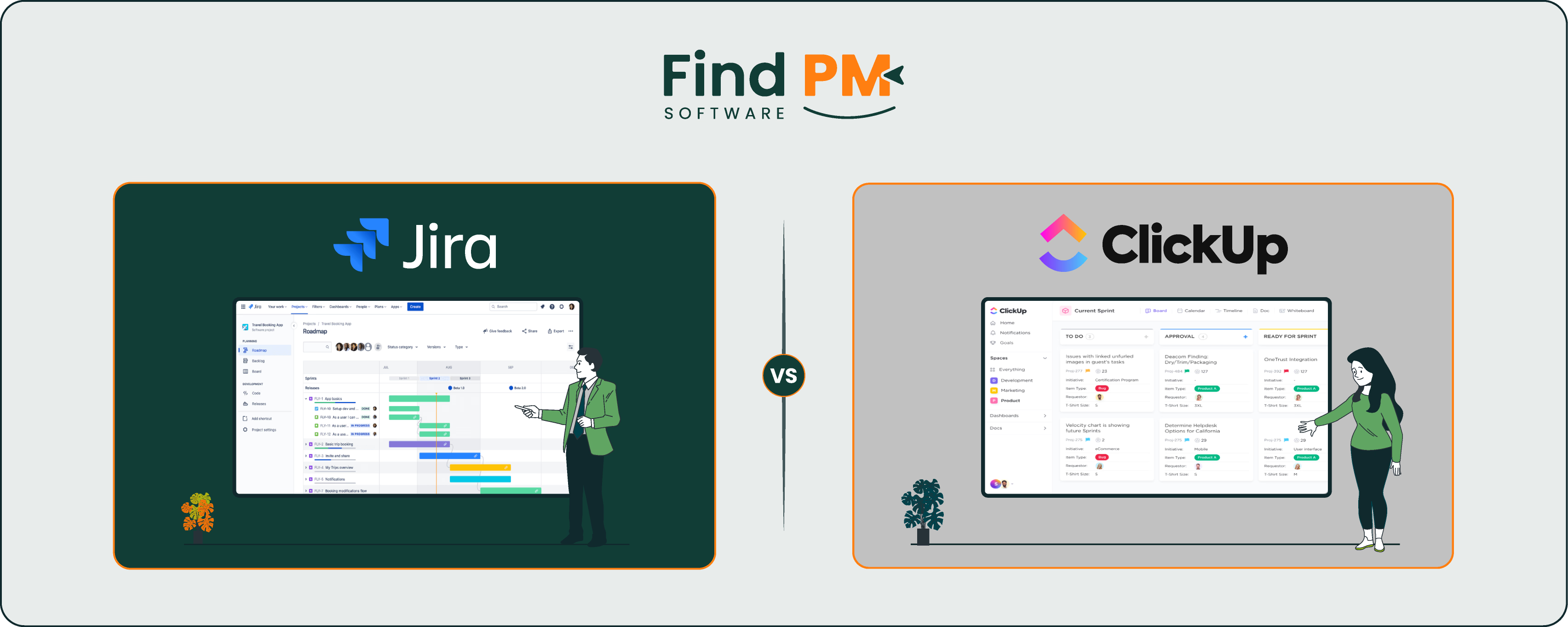
When it comes to project management software, choosing the right tool can significantly impact your team's productivity and efficiency. Two popular options in the market are Jira and ClickUp, each offering unique features and approaches to managing projects. While Jira is renowned for its robust issue tracking and Agile project management capabilities, ClickUp positions itself as an all-in-one productivity platform that caters to a wide range of teams and workflows. In this comparison, we’ll delve into the key differences between Jira and ClickUp across various aspects, including features, usability, pricing, and more, to help you determine which tool best suits your needs.
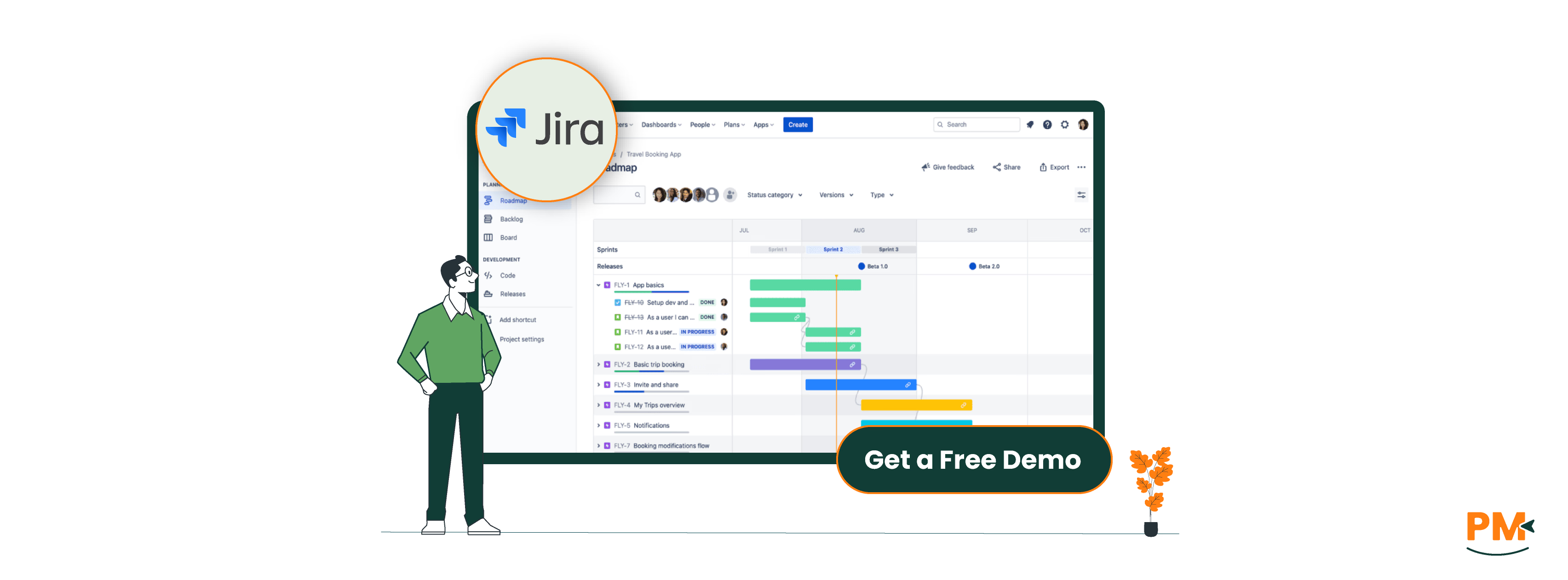
Jira, developed by Atlassian, is a leading project management tool designed primarily for software development teams. It excels in issue tracking, allowing teams to manage bugs, tasks, and user stories effectively. With strong support for Agile methodologies such as Scrum and Kanban, Jira offers features like backlogs, sprints, and customizable workflows. Its integration with other Atlassian products, such as Confluence for documentation, makes it a comprehensive solution for development teams. Trusted by over 300,000 companies globally, including 75% of Fortune 500 firms, Jira is known for its scalability and flexibility.
Jira Pros And Cons
Pros:
- Highly customizable workflows: Teams can tailor statuses and transitions to match specific processes
- Excellent for Agile project management: Supports Scrum and Kanban with dedicated boards and backlogs
- Robust issue tracking: Comprehensive features for managing bugs, tasks, and stories
- Integration with development tools: Seamlessly connects with tools like Bitbucket and Confluence
- Scalable for large teams: Suitable for small startups to enterprise-level organizations
Cons:
- Steep learning curve: Can be complex for new users, especially those unfamiliar with Agile practices
- Less intuitive for non-technical teams: Primarily designed for software development
- Requires additional tools for documentation: Relies on Confluence for robust documentation
- Performance issues with large datasets: May slow down with extensive issue tracking
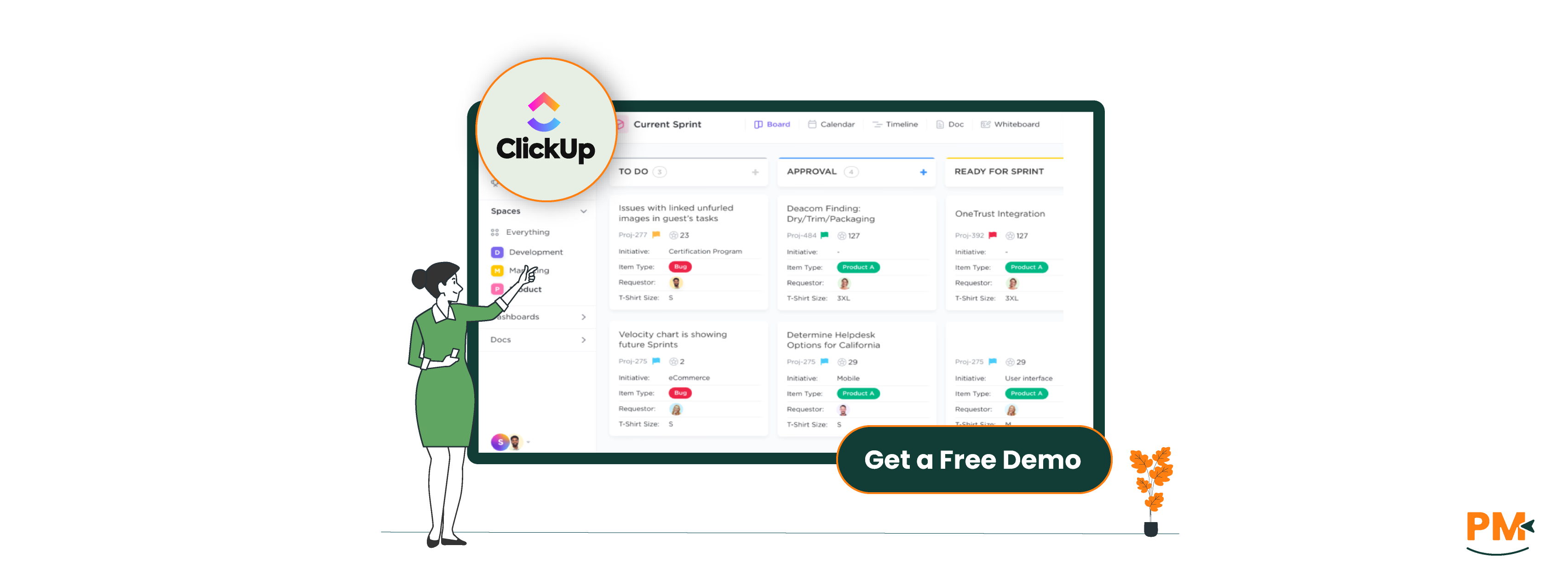
ClickUp is a versatile, cloud-based project management platform that aims to consolidate multiple productivity tools into one unified solution. Launched in 2017, it offers task management, document sharing, time tracking, goal setting, and real-time collaboration features. With over 800,000 teams using it, ClickUp’s flexibility allows it to adapt to various workflows, making it suitable for industries like marketing, design, and operations. Its customizable views and AI-powered features enhance its appeal for teams seeking an all-in-one workspace.
ClickUp Pros And Cons
Pros:
- All-in-one platform: Combines tasks, docs, chat, and more in a single interface
- Highly customizable: Offers multiple views (list, board, Gantt) and custom statuses
- User-friendly interface: Generally intuitive, with a modern design
- Generous free plan: Supports unlimited users with robust features
- AI-powered features: ClickUp Brain automates tasks and provides insights
Cons:
- Overwhelming feature set: Abundance of options can confuse new users
- Mobile app limitations: Some users report issues, particularly on Android
- Time-consuming setup: Customization requires significant initial effort
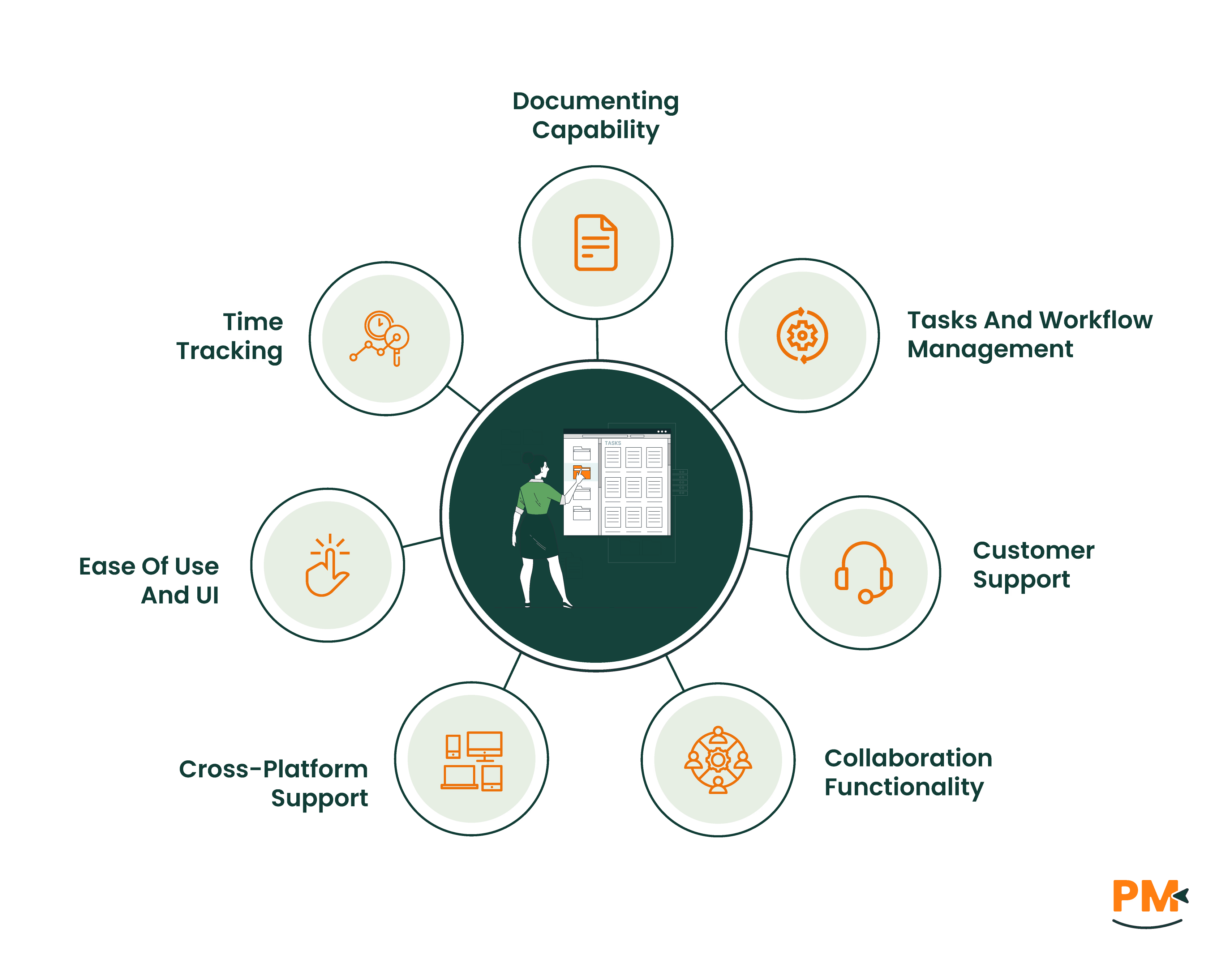
Jira
Jira’s task management revolves around “issues,” which can represent tasks, bugs, or user stories. These issues can be customized with fields like priority, assignee, and due dates, and linked to epics or sprints for Agile workflows. Workflows are highly configurable, allowing teams to define statuses (e. g. , To Do, In Progress, Done) and transitions to match their processes. Jira supports Scrum and Kanban boards, backlogs, and roadmaps, making it ideal for software development teams managing complex projects. However, setting up workflows can be complex and may require administrative expertise.
ClickUp
ClickUp provides a flexible task management system with a variety of views, including list, Kanban board, calendar, and Gantt charts. Users can create custom statuses and automate repetitive tasks using ClickUp’s automation tools, which include various actions, triggers, and conditions. The platform’s hierarchy (Spaces, Folders, Lists, Tasks) allows teams to organize projects at scale. ClickUp’s adaptability makes it suitable for diverse project types, from marketing campaigns to software sprints, though the extensive customization options may require time to master.
Jira
Atlassian offers a range of support options for Jira users, including comprehensive documentation, community forums, and direct support through their support portal. The level of support depends on the plan: Free plan users rely on community support, while Standard, Premium, and Enterprise plans offer 24/7 support for critical issues, with Premier Support providing dedicated engineers and proactive health checks.
ClickUp
ClickUp provides support through its help center, which includes articles, ClickUp University for self-paced learning, and live chat for paid plan users. Community forums allow users to share tips and solutions. Higher-tier plans, like Business and Enterprise, offer priority support and dedicated workflow experts. ClickUp’s support is praised for responsiveness, though some users note that the free plan’s support is limited to self-help resources.
Jira
Jira facilitates collaboration through comments, mentions, and issue-sharing features. Team members can discuss tasks directly within issues, assign tasks, and track progress in real-time. Integration with Confluence enhances collaboration by linking issues to detailed documentation. Additionally, Jira integrates with tools like Slack and Microsoft Teams for seamless communication. While effective for technical teams, Jira’s collaboration features may feel limited for teams needing built-in chat or real-time editing (Jira Collaboration).
ClickUp
ClickUp excels in collaboration with built-in features like real-time chat, collaborative docs, and whiteboards. Its collaboration detection shows when teammates are viewing or editing tasks, similar to Google Docs. Users can comment on tasks, assign action items, and share documents directly within the platform. With over 1,000 integrations, including Slack and Google Drive, ClickUp minimizes the need to switch tools, making it ideal for teams requiring tight collaboration.
Jira
Jira is accessible via web browsers, desktop apps (Windows and macOS), and mobile apps for iOS and Android. The mobile app allows users to create, edit, and track issues, view boards, and receive push notifications. While the web version offers advanced configuration, the mobile app ensures flexibility for on-the-go work. Some users note that complex tasks are better handled on the web version.
ClickUp
ClickUp offers web access, desktop apps (Windows, macOS, Linux), and mobile apps for iOS and Android. The mobile app supports task management, chat, and notifications, with features like widgets for quick access. Browser extensions for Chrome and email add-ons enhance accessibility. While the mobile app is functional, some users report occasional performance issues on Android.
Jira
Jira’s interface is fast and sleek, with built-in tutorials and customizable filters. However, its complexity can be a barrier for new users, particularly those unfamiliar with Agile methodologies. The abundance of options and templates can feel overwhelming, making it less intuitive for non-technical teams. Once mastered, Jira’s interface is powerful for managing complex projects.
ClickUp
ClickUp is praised for its modern, intuitive interface, with customizable dashboards and multiple views to suit different workflows. However, the extensive feature set can overwhelm new users, and the hierarchy (Spaces, Folders, Lists) may take time to understand. Interactive checklists and how-to videos help ease the learning curve, making ClickUp more accessible than Jira for diverse teams.
Jira
Jira includes built-in time tracking, allowing users to log time spent on issues, set estimates, and generate reports. Administrators can configure permissions to ensure accurate tracking. The Atlassian Marketplace offers apps like Tempo Timesheets to enhance functionality, providing AI-driven insights and automation. Jira’s time tracking is robust but may require additional setup for advanced needs.
ClickUp
ClickUp offers native time tracking with a global timer or manual entry, allowing users to track time across tasks and devices. Features include billable/non-billable labels and notes for context. Integrations with tools like Toggl and Harvest extend functionality. Timesheets and dashboards provide detailed reports, though some users find the interface less intuitive for time tracking.
Jira
Jira relies on integration with Confluence for documentation, offering a robust platform for creating wikis, knowledge bases, and collaborative documents. While Jira itself supports comments and attachments within issues, it lacks built-in rich text editing or standalone documentation features. Teams needing extensive documentation must use Confluence, which adds cost and complexity.
ClickUp
ClickUp includes built-in Docs for creating unlimited documents, wikis, and knowledge bases with rich text formatting and real-time collaboration. Whiteboards allow visual brainstorming and process mapping. Docs can be shared publicly without login, making ClickUp a more integrated solution for teams needing documentation within the same platform.

Feature | Jira | ClickUp |
Free Plan | Up to 10 users; 2 GB storage | Unlimited users; 100 MB storage |
Entry-Level Paid Plan | $7. 53/user/month (Standard) | $10/user/month (Unlimited) |
Mid-Tier Plan | $13. 53/user/month (Premium) | $19/user/month (Business) |
Enterprise Plan | Custom pricing; billed annually | Custom pricing |
Storage | 2 GB to Unlimited (depending on plan) | 100 MB to Unlimited (depending on plan) |
Support | Community to 24/7 Enterprise Support | 24/7 Support (for paid plans) |
Automation | Limited to Unlimited (based on plan) | Included in paid plans |
Disclaimer: The pricing is subject to change.
Jira is well-suited for teams seeking robust project management tools with scalable plans and enterprise-grade features. However, recent price increases should be considered when budgeting.
ClickUp offers a versatile platform with a generous free plan and competitive pricing for its paid tiers. Potential users should be aware of possible changes in feature availability and additional costs associated with certain functionalities

Jira is ideal for:
- Software development teams: Perfect for managing bugs, user stories, and sprints
- Teams practicing Agile methodologies: Strong support for Scrum and Kanban workflows
- Organizations needing issue tracking: Robust features for detailed task management
- Teams using development tools: Seamless integration with Bitbucket, GitHub, and Confluence
Who Is ClickUp Best For?
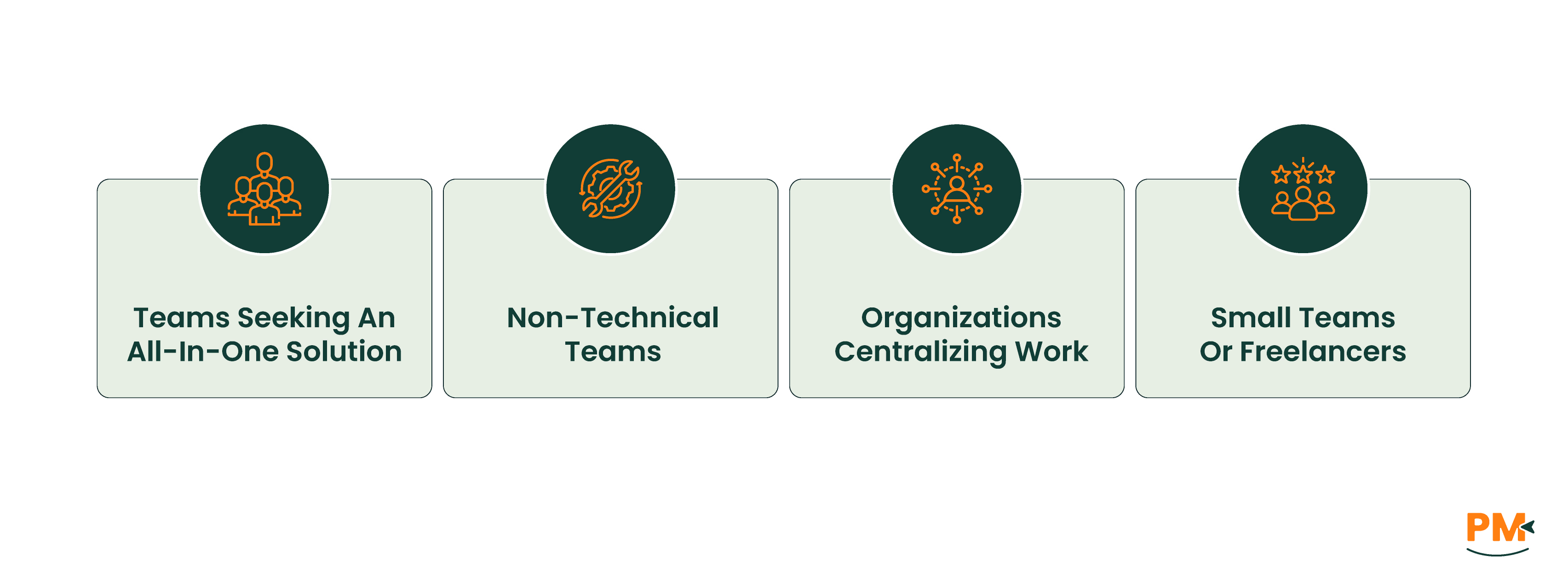
ClickUp is best suited for:
- Teams seeking an all-in-one solution: Combines tasks, docs, chat, and more
- Non-technical teams: Flexible for marketing, design, and operations workflows
- Organizations centralizing work: Reduces app sprawl with integrated features
- Small teams or freelancers: Generous free plan with unlimited users
The choice between Jira and ClickUp depends on your team’s needs. If you’re part of a software development team requiring robust issue tracking and Agile support, Jira’s specialized features and integrations make it a strong choice. However, if your team needs a versatile, all-in-one platform for diverse projects, ClickUp’s flexibility, built-in documentation, and collaboration tools may be more suitable. For small teams on a budget, ClickUp’s free plan with unlimited users is more generous than Jira’s 10-user limit. Consider testing both tools’ free versions to see which aligns best with your workflows.